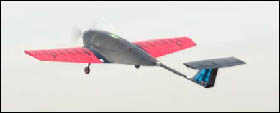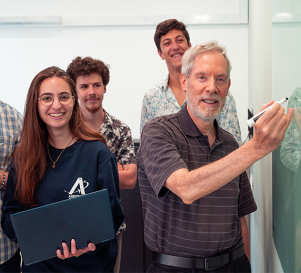Stringray – UAV for Design Build Fly Competition
- B. Knoh, A. Zameret, R. Wishlizky, S. Laloush, N. Melamud, L. Ankri, H. Levy, A. Wolf
- Shlomo Tsach
- Prof. Benjamin Landkof, Prof. Gil Iosilevskii, Mr. Jeffrey Meyer

The competition took place on April 21st 2006, at Cessna Aircraft Co. in Wichita, KS, USA. The team was required to design and build an aircraft in about six months taking into account the limitations laid down by the DBF competition management. The team thus decided to design a conventional UAV with a unique wing body shape.
The goal was to maximize the competition score, which is a combination of the report score, the total flight score and rated aircraft cost (RAC). Analysis of the mission requirements and estimates of the RAC showed that the best way to maximize the score was by optimizing the design of the airplane to fly the Payload Flexibility and Minimum RAC missions.
The conceptual design analysis focused on selecting the configuration. The competition rules were analyzed to deterimine design requirements, and to identify the most important elements of the design. The empty weight of the airplane was seen to be the most significant contributor to the competition score, so minimizing the empty weight was a major objective throughout the design process. Three different configurations were studied: conventional layout, flying wing and hybrid. A comparison table was used to select the most suitable configuration. For the chosen configuration – hybrid – an additional screening process utilizing FOM tables was used to optimize the design. In the preliminary design phase a more profound analysis was carried out to further optimize the configuration.
Critical design variables were identified and used to investigate optimal sizing. More detailed aerodynamic trade-off factors were studied and a stability and control analysis were then conducted to refine the design. The computer code was updated to investigate the critical design variables such as: wing area, wingspan, boom length, airfoil and fuselage length, empennage size, motor selection, propeller size and pitch and battery selection.
In accordance with those variables the performance and the stability characteristics of the design were analyzed and optimized. The final results were an airplane with a wing area of 8.82 ft, an aspect ratio of 5.66, a fuselage length of 3.6 ft and a propusion system utilizing a Hacker B50-13S motor with a 6.7:1 gearbox, 16 IB 1200 cells and a 16×10 propeller. The aerodynamic analysis led to the selection of the SD7062 airfoil for the wing and the NACA0010 for the T-tail surfaces. The empennage and control surfaces were sized using static and dynamic stability and control analyses.
In the detailed design phase the different internal components were selected to finalize the design, and on the results of the preliminary design stage, the strength and stability requirements were met while reducing the weight of the airplane. The computerized 3D model was then updated and the manufacturing drawings of the airplane were generated. In addition to the empirical analyses, a number of experiments were performed for verification. The predicted empty weight (=RAC) for the Stingray was 5.5 lb and the predicted total flight score was approximately 45 points, for an estimated loading time of 25 sec.
The team was placed 8th out of fifty teams which competed.
Links
http://www.ae.uiuc.edu/aiaadbf/








